Tribal Profiles
- Tribal Profiles
- Southwest Region
- Bidii Baby Foods
- Bishop Paiute Tribe
- Diné Native Plants Program
- Fort McDowell Yavapai Nation
- Hopi Earth Day
- ITEP’s SW Tribal Climate Change Project
- ITEP’s Academic Year Internship Program
- Jemez Pueblo Renewable Energy
- La Jolla Band of Luiseño Indians
- Mescalero Apache Tribe
- Native Seeds/Search
- Navajo Nation Dune Study
- North Leupp Family Farms
- Pueblo of Tesuque
- Pueblo de San Ildefonso Climate Action Plan
- Santa Ynez Band of Chumash Indians
- Tohono O’odham
- Ute Mountain Ute
- Wind River
- Tribal Profiles
- Southwest Region
- Bidii Baby Foods
- Bishop Paiute Tribe
- Diné Native Plants Program
- Fort McDowell Yavapai Nation
- Hopi Earth Day
- ITEP’s SW Tribal Climate Change Project
- ITEP’s Academic Year Internship Program
- Jemez Pueblo Renewable Energy
- La Jolla Band of Luiseño Indians
- Mescalero Apache Tribe
- Native Seeds/Search
- Navajo Nation Dune Study
- North Leupp Family Farms
- Pueblo of Tesuque
- Pueblo de San Ildefonso Climate Action Plan
- Santa Ynez Band of Chumash Indians
- Tohono O’odham
- Ute Mountain Ute
- Wind River
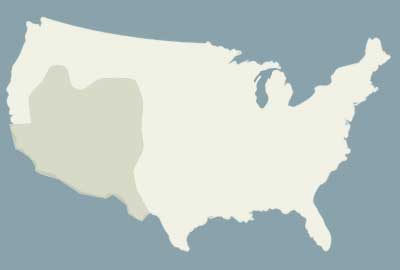
Fort McDowell Yavapai Nation
Harnessing Solar Power for Energy Independence and Utilities Savings
Click HERE for PDF version.
The Fort McDowell Yavapai Nation is located east of Phoenix in central Arizona. Not surprisingly, the large deserts of Arizona, including those in the Phoenix area, “offer some of the highest solar power potential in the country” according to the U.S. Energy Information Administration (see Figure 1; US EIA, 2009). In addition to the greenhouse gas reductions associated with renewable energy, the Fort McDowell Yavapai Tribe long ago realized the tremendous financial incentives posed by solar power. As Dan Catlin, Air Quality Specialist for the tribe explains, “Arizona should be on the forefront of solar energy. A lot has happened economically [in the energy sector] and as rates go up, the value of solar goes up.”
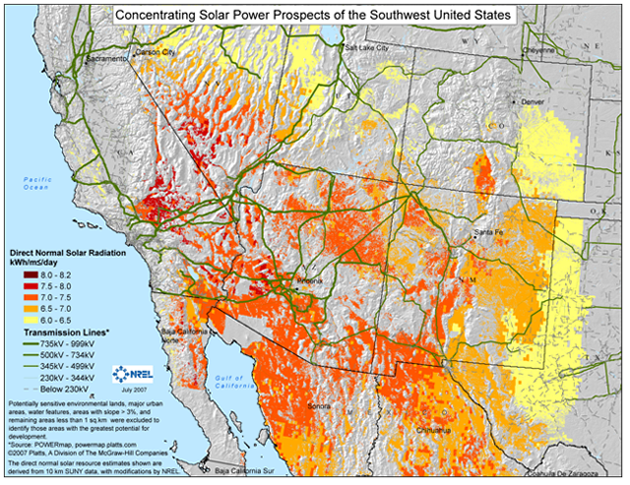
United States Provided courtesy of the National Renewable Energy Laboratories (NREL), 2010.
Solar Photovoltaic Demonstration System
Project Implementation and Progress
In the interest of educating community members on the benefits of renewable energy, the tribe decided to install a solar demonstration project. The planning for this project began in early 2009 and a little over a year later, in March 2010, installation of the 12-kilowatt (kW) demonstration project was complete.
The system was initially expected to provide 15-20 percent of the energy for tribal headquarters building 2 (HQ2). As of mid-2010 however, the installation has been providing about 23 megawatt hours of energy annually, which is over 22% of the electricity used by HQ2. In order to fund the HQ2 solar demonstration project, which cost approximately $54,000, the tribe received approval to use funds from a section 103 Clean Air Act grant combined with about $27,000 worth of rebates from Salt River Project (SRP), one of Arizona’s largest utilities. In order to contract with the most qualified and affordable solar installer, a number of solar contractors were interviewed. Following the interview process and bid requests in the summer of 2009, the tribe awarded the project to a company by the name of S3 Energy, a Phoenix-based company.
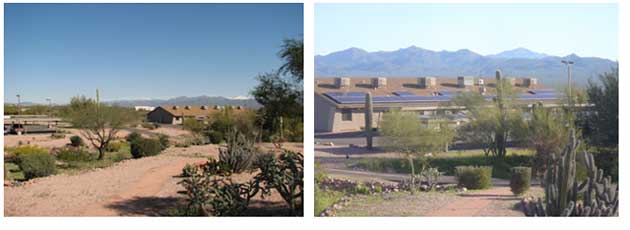
Air Quality Monitoring Station Solar System
Project Implementation and Progress
In addition to the demonstration project on HQ2, the tribe also operates a small, 1.5 kW solar tracking system on the air quality monitoring station (see photo below). The six 250-watt panels track solar radiation throughout the day and currently produce about 50% of the monitoring station’s energy.
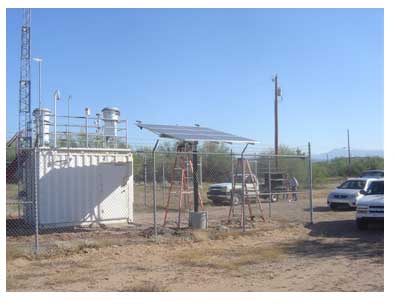
Moving forward, the tribe plans to install a second PV tracking system for the monitoring station after which they expect energy from the sun to produce as much electrical energy as the monitoring station uses.
Future Projects
Given the success of the solar demonstration project, the tribe is investigating options for other, larger renewable energy installations. Currently, work is being completed on a feasibility study for a 1-megawatt (MW) project. The solar PV system would supply energy to the tribe’s minimart gas station, an RV park, and a wastewater treatment plant. Catlin explains that there are far reaching implications for these renewable energy projects. For instance, by using a purchase power agreement (PPA), the tribe could finance the project, lower utility expenses, and simultaneously reduce tribal reliance on fossil fuel-generated electricity.
Key Partners
- US Environmental Protection Agency – Tribal grant funding through Clean Air Act section 103
- National Renewable Energy Laboratory – Greenhouse gas reduction calculator
- S3 Energy – Solar installation contractors
- Salt River Project – electric utility
- Dependable Solar – installation of the solar PV system tracker
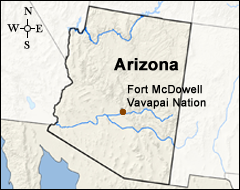 About the Fort McDowell Yavapai
About the Fort McDowell Yavapai
Fort McDowell Yavapai Nation (FMYN) is situated along the Verde River within the Fountain Hills Sub-basin. This forty square mile community is located in the northeast portion of Maricopa County and is on the far northeastern edge of the Phoenix Metropolitan Area. The FMYN lands contain a number of enterprise activities, such as sand and gravel facilities, a golf course/resort/convention center, a casino, a gas station, a recreational vehicle park, a farm, and an outdoor recreation facility (Arizona Adventures).
References and Resources
- Fort McDowell Yavapai Nation Website:
http://www.fortmcdowell.org/ - National Renewable Energy Lab (NREL), Science & Technology. (2010) Concentrating Solar Power Research, Concentrating Solar Power Resource Maps.
http://www.nrel.gov/csp/maps.html#south - Salt River Project (SPR) Renewable Energy Credit (REC) program for businesses:
http://www.srpnet.com/environment/earthwise/business.aspx - US. Energy Information Administration (2009). Arizona – State Energy Profile Analysis:
http://www.eia.gov/beta/state/analysis.cfm?sid=AZ - US Environmental Protection Agency, Region 9. Clean Energy and Climate Change:
http://www.epa.gov/region9/climatechange/tribes/index.html
Project Contacts:
Dan Catlin
480/789-7166
Air Quality Specialist
Fort McDowell Yavapai Nation Environmental Department
Photos in this profile are courtesy of the Fort McDowell Yavapai Nation Environmental Department.
This profile was developed by Cristina González-Maddux, Institute for Tribal Environmental Professionals, Northern Arizona University, with financial support from the USDA Forest Service. The profile is available on the Tribal Wellbeing for Seven Generations Program website: https://itep.nau.edu/twsgp/tribes/. The tribal profiles featured on the website are intended to be a pathway to increasing knowledge among tribal and non-tribal organizations interested in learning about climate change mitigation and adaptation efforts.
CONNECT WITH US
Nikki Cooley
Co-Director
Nikki.Cooley@nau.edu
Karen Cozzetto
Manager
Karen.Cozzetto@nau.edu
Your tax deductible donation supports ITEP’s programming efforts.
Please contact us if you would like to contribute to our endowment or for any additional information regarding donations.

